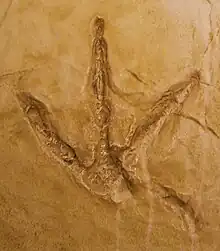| Saurexallopus Temporal range: Late Cretaceous | |
|---|---|
 | |
| Saurexallopus zerbsti (holotype CU-MWC 224.2) from the Lance Formation | |
| Trace fossil classification | |
| Domain: | Eukaryota |
| Kingdom: | Animalia |
| Phylum: | Chordata |
| Clade: | Dinosauria |
| Clade: | Saurischia |
| Clade: | Theropoda |
| Clade: | Maniraptora |
| Ichnogenus: | †Saurexallopus Harris, 1997 |
| Type ichnospecies | |
| †Saurexallopus lovei Harris, 1997 | |
| Other species | |
| |
| Synonyms | |
|
Exallopus lovei Harris et al., 1996 | |

Saurexallopus (meaning "reptile different foot") is an ichnogenus of four-toed theropod footprints from the Late Cretaceous period. The type ichnospecies is S. lovei, named and described in 1996 from the Harebell Formation.[1] The taxon was originally named Exallopus, but later renamed as Saurexallopus as the former was preoccupied by a polychaete.[2] A second species, S.zerbsti, was named and described in 2004 from the Lance Formation.[3] In 2012 a four-toed track from the Cantwell Formation was referred to Saurexallopus indet. It was also suggested that Saurexallopus was produced by a therizinosaur taxon.[4] In 2013 based on skeletal proportions it was suggested that the ichnotaxon was instead produced by an oviraptorosaur taxon.[5] In 2014 a third species was named, S.cordata, from the Wapiti Formation.[6] In 2018 several tracks from the Blackhawk Formation were referred to Saurexallopus indet.[7]
See also
References
- ↑ Harris, J. D.; Johnson, K. R.; Hicks, J.; Tauxe, L. (1996). "Four-toed theropod footprints and a paleomagnetic age from the Whetstone Falls Member of the Harebell Formation (Upper Cretaceous : Maastrichtian), northwestern Wyoming". Cretaceous Research. 17 (4): 381−401. Bibcode:1996CrRes..17..381H. CiteSeerX 10.1.1.590.9821. doi:10.1006/cres.1996.0024.
- ↑ Harris, J. D. (1997). "Four-toed theropod footprints and a paleomagnetic age from the Whetstone Falls Member of the Harebell Formation (Upper Cretaceous : Maastrichtian), northwestern Wyoming: a correction". Cretaceous Research. 19 (1): 139. Bibcode:1997CrRes..18..139H. CiteSeerX 10.1.1.694.2865. doi:10.1006/cres.1996.0053.
- ↑ Lockey, M. G.; Nadon, G.; Currie, P. J. (2004). "A Diverse Dinosaur-Bird Footprint Assemblage from the Lance Formation, Upper Cretaceous, Eastern Wyoming: Implications for Ichnotaxonomy" (PDF). Ichnos. 11 (3–4): 229−249. doi:10.1080/10420940490428625.
- ↑ Fiorillo, A. R; Adams, T. L. (2012). "A Therizinosaur Track from the Lower Cantwell Formation (upper Cretaceous) of Denali National Park, Alaska". PALAIOS. 27 (6): 395−400. Bibcode:2012Palai..27..395F. doi:10.2110/palo.2011.p11-083r. S2CID 129517554.
- ↑ Gierlinski, G.; Lockley, M. (2013). "A Trackmaker for Saurexallopus: Ichnological Evidence for Oviraptorosaurian Tracks from the Upper Cretaceous of Western North America". In Titus, A. L.; Loewen, M. A. (eds.). At the Top of the Grand Staircase: The Late Cretaceous of Southern Utah. pp. 526−529.
- ↑ McCrea, R. T.; Buckley, L. G.; Plint, A. G.; Currie, P. J.; Haggart, J. W.; Helm, C. W.; Pemberton, G. S. (2014). "A Review of Vertebrate Track-Bearing Formations from the Mesozoic and Earliest Cenozoic of Western Canada with a Description of a New Theropod Ichnospecies and Reassignment of an Avian Ichnogenus". New Mexico Museum of Natural History and Science Bulletin. 62.
- ↑ Lockley, M.; Gierlinski, G.; Adach, L.; Schumacher, B.; Cart, K. (2018). "Newly Discovered Tetrapod Ichnotaxa from the Upper Cretaceous Blackhawk Formation, Utah". New Mexico Museum of Natural History and Science Bulletin. 79.
External links
 Media related to Saurexallopus at Wikimedia Commons
Media related to Saurexallopus at Wikimedia Commons